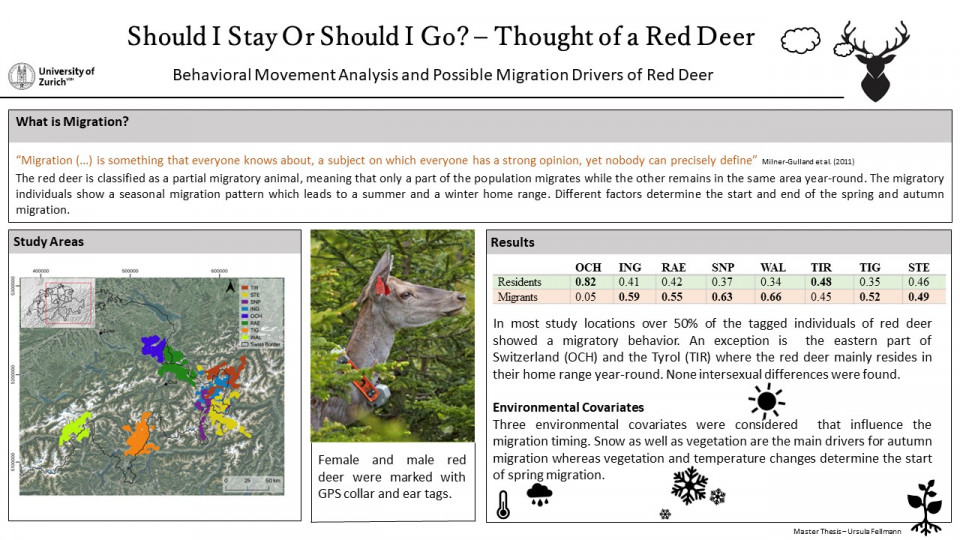The red deer (Cervus elaphus) is a common ungulate in Switzerland, Austria and Italy. The different characteristics like a high climatic variability and various anthropogenic influences of these areas make it difficult to predict the movement of red deer. The aim of this thesis is to analyze red deer migratory behavior with respect to propensity and distance in eight different study areas. Furthermore, the timing of migration in spring and autumn is investigated in relation to environmental covariates.
First, the migration pattern of 346 red deer were analyzed using MigrO, a QGIS plug-in based on the SeqScan algorithm. Defined criteria were applied to classify the red deer trajectories into migratory, resident, and disperser individuals. For the following analysis the focus lied on the migratory and resident red deer. Next, the home range size (HRS), altitude, distance and timing were analyzed for all populations. These parameters are all outputs of MigrO. The results for all parameters of the eight study areas were then compared. Furthermore, intersexual differences were looked at. Influences of environmental factors such as snow, vegetation and temperature on migration timing were then investigated with the Cox Proportional Hazard Model. For snow, the Normalized Difference Snow Index (NDSI) was used, provided by MODIS Aqua. Vegetation was predicted by the Normalized Difference Vegetation Index (NDVI) supplied by MODIS Terra and for temperature data the Land Surface Temperature (LST) by MODIS Aqua was used.
The different results for the migration probability per study site showed that red deer behavior is dependent on various environmental factors (i.e. weather conditions and topology) and anthropogenic influences like hunting, supplementary forage and human made barriers. In addition, only moderate intersexual differences were observed for the behavior. Moreover, few red deer individuals (females and males) traveled to rutting grounds outside of their seasonal home ranges.
Resident animals show a larger covered HRS than migratory individuals. Consequently, resident individuals likely roam larger areas within one larger annual range, while migratory animals fulfill their needs in two spatially separated smaller ranges. Stags cover a larger HRS than hinds and generally also have their home ranges at lower altitudes than female red deer. Generally, all migratory individuals traveled to lower elevations during winter and migrated to higher altitudes in summer. The traveled distances between the home ranges were evenly distributed between hinds and stags. Only on the study site in Tyrol, where supplementary feeding has a long tradition in winter, the traveled distances are significantly lower than compared to the other study sites, suggesting effects of supplementary feeding in altering migration behavior. The spring migration starts earlier for stags than hinds, whereas in autumn the stags migrate all at once in a short time. This is assumed to be in relation to an event like for example the end of hunting or changing weather conditions.
The results of the Cox Proportional Hazard Model shows that the timing of spring migration is assumed to be determined by changes in vegetation and temperature, while the determinant driver for the autumn migration is snow.
Overall the results show plastic responses of red deer to environmental and anthropogenic drivers. Differences in the studied populations show that various factors influence the migration behavior of red deer which need still more research to fully understand the mechanism.
